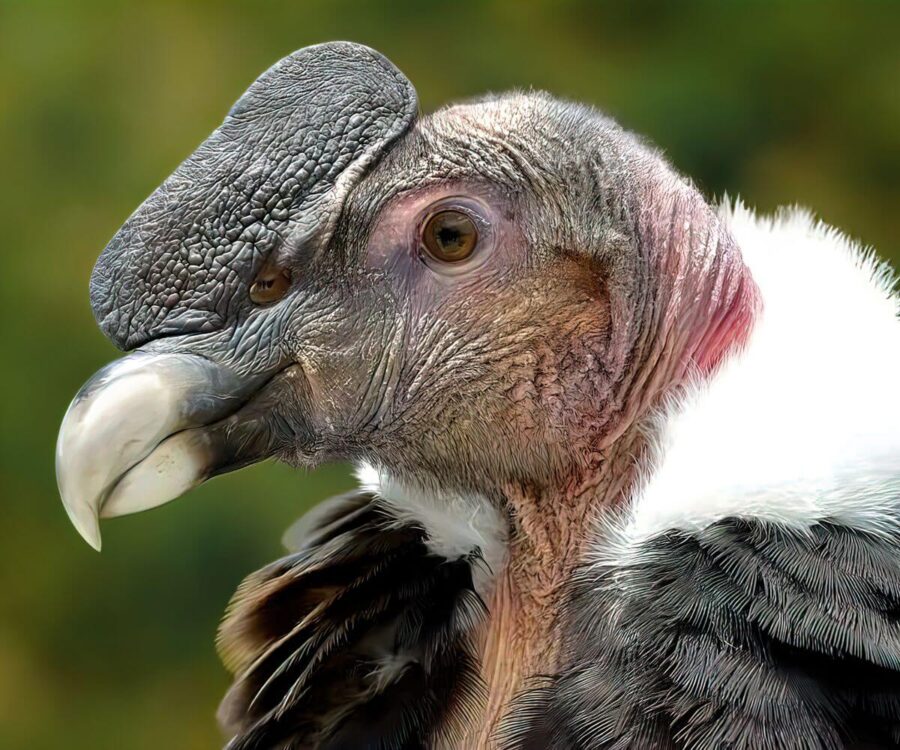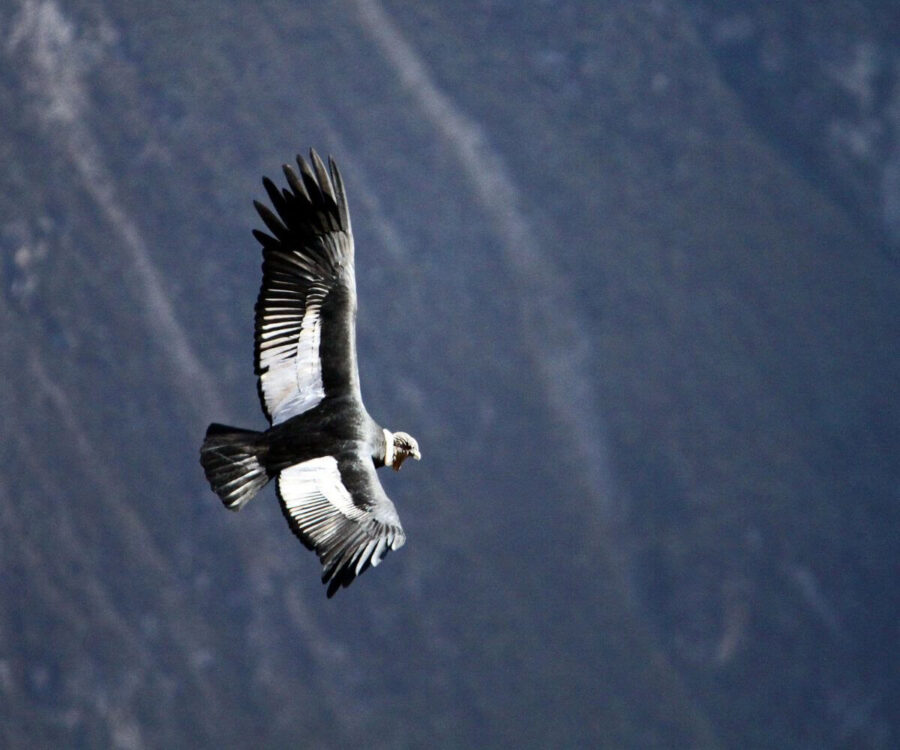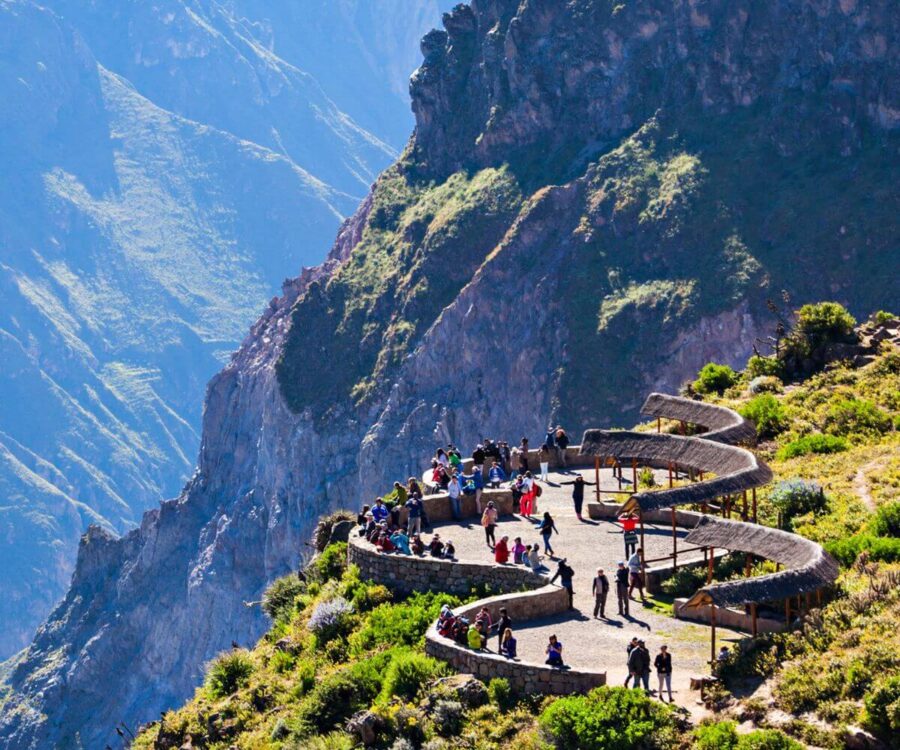The Andean condor, one of the largest birds in the Andes, is now endangered due to habitat loss and other threats. In Peru, this species can be observed in its natural environment, and there are now tours specifically for condor watching. If you want to experience new adventures and learn more about this bird, this guide is for you.
Table of Contents
Peru is home to many birds, but the condor is one of the most outstanding due to its majesty while flying, especially because it does so at great altitudes, making it a very special animal. Consider the following:
The Andean condor (Vultur gryphus) has a wingspan of approximately 3.3 meters, and its weight ranges from 11 to 15 kilograms. It is distinguished by its shiny black plumage, a white collar that adorns its neck, and a characteristic fleshy crest found in males.
You can admire its flight in large dimensions, especially in the mornings when most of these animals take to the skies. You can observe them from strategic points designed for sightings.

This bird inhabits the Andes Mountain Range, which spans several countries. In Peru, it is found in areas such as the Cañón del Colca and the Cañón de Apurímac, as these places offer the ideal conditions needed for the condor's survival. Nowadays, tours allow visitors to observe its natural habitat and learn about its conservation.
The condor feeds on carrion, playing a vital role as a cleaner of ecosystems. This habit makes it essential for large areas and wildlife populations that depend on it. If you visit the condor's habitat, specialized guides will explain how these animals glide (flight behavior) and other aspects of their behavior.
The Andean condor is classified as a "near-threatened" species globally and "endangered" in countries like Peru due to poisoning and hunting. The government is running educational campaigns to reduce human threats.
The Andean condor faces multiple threats, including:
Efforts to protect the condor include captive breeding programs to reintroduce them into the areas where they live and protected areas. This goes hand in hand with environmental education campaigns in Peru. In our case, Terandes supports these efforts through tours focused on education and sustainability.
The condor is essential to the Andean ecosystems, as it helps prevent the spread of diseases by consuming carrion. Moreover, its presence holds deep cultural significance in Andean traditions, where it is considered a symbol of power and spiritual connection.
There are many questions about the condor, such as how long it can live or what it eats. Here are some fun facts about this bird:
This bird, thanks to its long and strong wings, can glide for hours without flapping them, using air currents to reduce energy consumption. Places like the Cañón del Colca are ideal for observing this behavior, especially while enjoying the magnificent views.
In Andean culture, the condor represents the sky and the divine, forming part of the sacred trinity alongside the puma (the earth) and the serpent (the underworld). Its importance is reflected in various local traditions and festivities.

The condor can live up to 70 years, making it one of the longest-living birds. Interestingly, its reproduction is slow, as a pair of condors only raise one chick every two years, which poses a challenge to its conservation.
Conservation measures for the condor include the creation of protected areas, captive breeding programs, and awareness campaigns, among others:
In Peru, projects like "Cóndor Pasa" aim to monitor and protect wild condor populations. During our tours, we offer educational talks to inform visitors about the importance of these initiatives.
We support local measures to combat the illegal wildlife trade, which affects the region's biodiversity. The tours include visits to communities committed to sustainable practices and the protection of the condor.
With Terandes, you can support the preservation of this species by participating in responsible tours that benefit local communities promoting ecotourism.
To spot the Andean condor, places like the Colca Canyon and Apurímac Canyon are ideal, where you can observe their flight in their natural habitat.
1. Tour to Colca Canyon (Arequipa):

2. Tour to Apurímac Canyon (Cusco):
3. Private Tour to Natural Reserves:
The Andean condor is distributed across many countries, with areas like the Colca Canyon and Apurímac Canyon in Peru being home to the largest populations, where protection and monitoring programs are implemented.
The Colca Canyon is one of the main areas to observe, as it has a regular population of this bird and is easily accessible. Other highlighted areas include the Manu National Park, known for its rich flora and fauna.
Andean ecosystems are essential for their survival, providing the necessary resources for their existence. These ecosystems benefit not only the condor but also other species whose main source of life is these areas.
